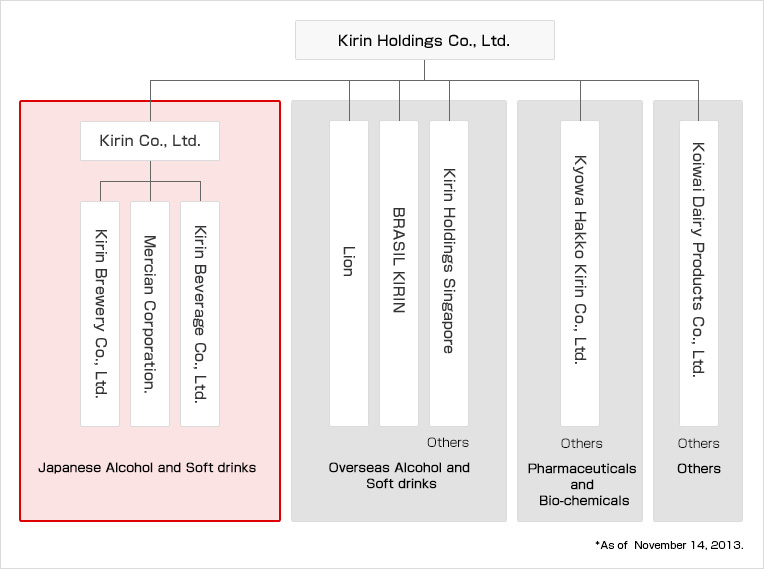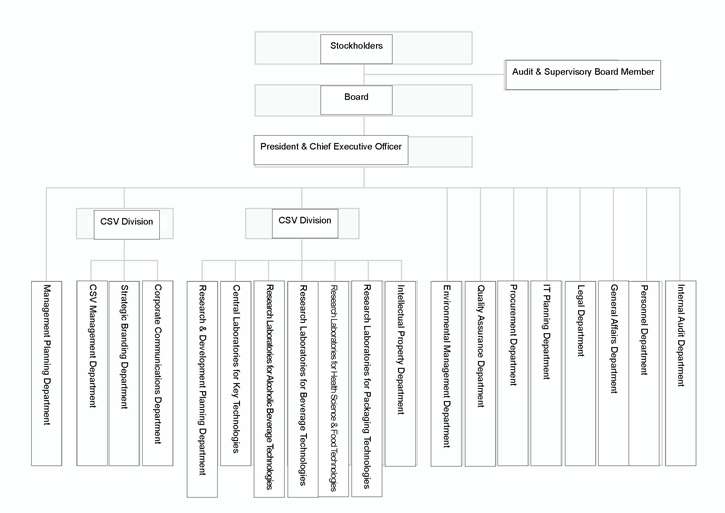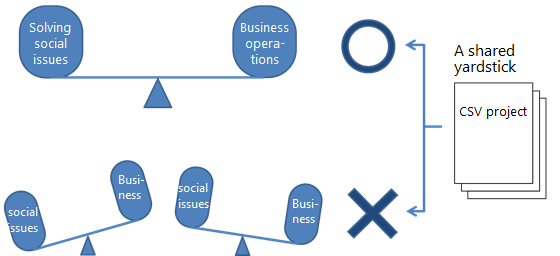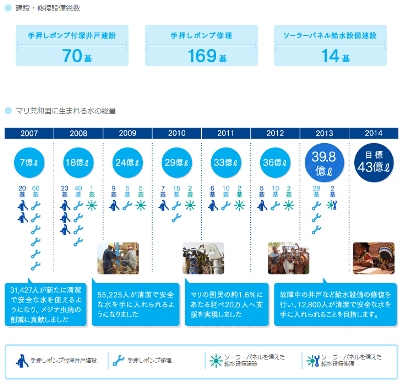- Article
- Industry, Business, Technology
A Branding Strategy for Creating Shared Value: Kirin Group
September 16, 2015
Achieving Growth in a Mature Market
The Japanese beverage market is extremely competitive. Not only is the overall market shrinking due to the low birthrate and aging population but young people are also drinking less alcohol. Happoshu and other beer-like drinks have become popular with the public, and price competition is getting fiercer. The retailing structure is also changing, with a shift from old-fashioned neighborhood liquor stores to large-scale chains. A similar situation is faced by the soft drinks sector, where a gradual fall in prices is continuing.
While this might be welcomed by consumers, it is a tough situation for companies. For those competing in this mature market, achieving sustainable growth is more important than ever. When we look at the global food and beverage industry, we see that companies like Nestle and Unilever have been proactive in placing CSR at the center of their corporate strategy.
The Kirin Group’s regional headquarters for Japan, Kirin Company, Ltd., benchmarked the practices of those industry leaders and outlined what it should do (Figure 1). The first answer was “operational restructuring”. The second was a move to “brand-centered management.”
Figure 1. Operations of the Kirin Group

Kirin has resolved to shift from conventional CSR (corporate social responsibility) to CSV (creating shared value) with the aim of creating synergies between its social initiatives and business operations. The concept of CSV has been expounded by Harvard University professor Michael Porter based on the idea that creating value shared by both society and businesses is integral to the competitive strategies of those companies.
Consumers do not usually think about the global impact of everyday products. For example, it might be difficult for them to picture how the manufacturing process of a product affects the ecosystem of a distant part of the world.
But this could change if companies had greater awareness of how their business operations are connected to social issues and informed customers of their efforts to address them. The result would be a fuller understanding of those issues, which could lead to stronger affinity with the company.
Kirin strives to create social value through six themes: (1) protecting human rights and working conditions and (2) prevention of corruption, which are compliance issues; (3) food safety and security and (4) protecting the environment, which relate to sustainability; and (5) strengthening bonds between people and society and (6) well-being, which are themes that Kirin is characteristically well-positioned to address.
CSV Division
So how exactly does Kirin go about realizing a brand strategy that creates social value? Kirin has realigned and consolidated its domestic drinks business (Figure 2). First, it merged its separate R&D departments for beer (and other alcoholic drinks), nonalcoholic drinks, and wine into the Research & Development Planning Department.
It also set up a CSV Division to look after brand strategy, as well as to advance the integration of the company’s initiatives to address social issues and its main business operations.
The CSV Division consists of the CSV Management Department, Strategic Branding Department, and Corporate Communications Department, and its mission is to advance “brand-centered management,” employing a long-term perspective based on unified management of CSV and product brand strategy.
Figure 2. Kirin’s Corporate Structure (as of January 2013)

Typically, CSR departments that deal with social issues work and think according to a longer timescale than other departments and can find itself at odds with the rest of the company. But at Kirin, because the department is also responsible for brand strategy—which, too, employs a longer timescale—the company has created an environment where CSR initiatives are not forced to conform to the short-term pace of other business operations. Even when differences in perception arise, they can be harmonized over a longer span of time.
Because it is also responsible for branding, the CSV Division has the resources and the authority to undertake those activities. And by drawing on its corporate communications functions, it is capable of supporting new marketing approaches. Needless to say, the division is responsible for promoting the integration of the company’s social initiatives and business operations. By linking these various functions it can deepen understanding of CSV and facilitate its implementation. It has been given a solid position within the company’s human resources structure, indicating the strong commitment the company is making to pursuing CSV.
There are few companies with a similar philosophy of creating shared value for society and business or that place the department responsible for such creation at the core of its business strategy and corporate structure. In most cases, CSR departments are positioned within such administrative divisions as general affairs or public relations. It is rare for them to be incorporated into management planning or for them to share strategies with core business operations.
Companies will increasingly need to integrate their social initiatives and business operations to secure a respected place in society, and the failure to do so will expose them social “landmines” that could seriously damage the company’s reputation or public image. The restructuring of Kirin’s business is one organizational response to achieving that integration.
A Framework for Integration
Kirin’s innovations are not just organizational; they are found throughout the company’s operations and in the work performed by individual employees.
When many companies plan to launch a new project or make an investment, they usually base their decisions on internal documents that summarize the meaning of the project for the company and include such information as market potential, the company’s strengths, and the amount to be invested and likely returns. When the decision is about ways to innovate or improve business practices, the document may contains facts about required technologies and cost advantage so as to facilitate decision-making by management and further discussions by the departments concerned. The document becomes a guide for action and may be described as the project’s DNA. It can also serve as a catalyst for further innovation, so companies devote considerable energy to creating the most useful documents they can.
Kirin believes that creating social value will enhance its brand strength, promote human resources development, and ultimately boost its competitiveness. This requires striking a balance between its social initiatives and business operations. To check whether this balance has been achieved, Kirin has created a common a yardstick to measure the success of both activities, which is used throughout the company (Figure 3). When a CSV project is heavily focused on solving social issues without relevance to business operations, it will be little more than conventional corporate philanthropy. If, on the other hand, it is slanted toward profit (which both management and employees are inherently pursuing), the company will find itself trapped within the constraints of a competitive business environment.
Figure 3. Kirin’s Integration Strategy

Kirin likely decided on this approach because of Japan’s highly competitive beverages market. In this environment, many new products have very short lifespans, quickly falling by the wayside as victims of price competition.
This may also be regarded as the roots of Kirin’s CSV, as it needed to manufacture products with shared value for both society and business under what is called the Kirin integration strategy.
Learning from Past Successes
A philosophy is often not enough to significantly boost competitiveness. Kirin thus took a renewed look at its past successes and discovered a common point among them: they all combined social initiatives and business operations. Examples of such success were shared among the managers and staff.
The Great Tokyo Earthquake of September 1923, for example, damaged Kirin’s Yokohama factory, forcing it to boost production at its newly built factory in Sendai. While it succeeded in increasing output, it faced a problem in shipment. At the time, bottled beer was packed in wooden crates, and the bottles would strike against each other and often break during transport.
So that the bottles would not break, the Sendai factory asked local farmers to produce bundles of rice straw as cushioning material. From the company’s perspective, they were able to reduce the number of damaged bottles, while from the farmers’ viewpoint, they were able to earn twice as much money as from their usual rope-making side work during the off-season, meaning that they did not need to leave their farms to find work in the cities. Kirin regards this project as the start of its CSV initiatives—a project that created value both for the local community and the company itself.
Another example is a project initiated by Volvic, a mineral water company that is now part of the Kirin Group. The project’s name is “Drink 1, Give 10.” Each time a customer buys a liter of bottled water, the company donates funds to UNICEF to enable the provision of 10 liters of drinking water to residents in Mali (Figure 4).
Figure 4. Support Enabled by Volvic’s “Drink 1, Give 10” Campaign

UNICEF’s Mali office has a project to dig wells and maintain them for the first 10 years of use. The program has provided 3.98 million liters of clean water from 70 new wells, repaired 169 hand pumps, and installed 14 solar-powered water supply systems (as of September 2013). The under-5 mortality rate in Mali is quite high, partly due to infectious diseases. The clean and safe water from this project can help prevent infection and can allow children—who no longer need to walk long distances to fetch water—to go to school.
This program has led to a significant increase in Volvic’s sales. Customers were attracted by the opportunity to support the lives of people in a far-off country simply through their purchase of mineral water.
Helping Prevent Drunken Driving
A third example is the launch of Kirin Free, a nonalcoholic, beer-like beverage. This product was born from the company’s desire to eradicate drunken driving. Japan’s liquor tax law classifies drinks containing less than 1% alcohol as “nonalcoholic.” But you would still be guilty of drunken driving if you operate a car after drinking such a beverage. Kirin Free is a drink with 0.0% alcohol. The company promotes Kirin Free for people who need to drive home from parties, golf trips, and barbeques.
As part of its marketing for the product, Kirin chose to support the “Designated Driver” campaign, under which one member of a group at a restaurant or bar is chosen as the driver. The designated driver does not consume alcohol, and the others (including shop employees) also make sure that he or she does not drink. The driver is responsible for driving everyone back home safely.
While the immediate motive for creating this product was to address a social issue, Kirin Free caught on with consumers other than those interested in preventing drunken driving. It was embraced by a much broader segment of society, leading to the creation of a new, nonalcoholic drinks market.
Upstream Innovations
Kirin’s successes in creating new markets also include initiatives upstream in the value chain, including in the procurement of raw materials. Mercian, a member of the Kirin Group that makes wine, established the Mariko Vineyard in Ueda, Nagano Prefecture, in 2003 and launched its own grape cultivation with an eye to improving the quality of domestic wine and boosting consumption.
While the land was suitable for grape cultivation, it had lain idle for years. With the help of local volunteers, Mercian built a farm and began growing grapes. Seven years later, in 2010, Mercian sold its first vintage wine. It was immediately praised for its high quality, winning a gold medal at a domestic wine competition. This project enabled Mercian to not only expand the market for domestically produced wine but to also enhance the value of its brand.
Other value chain improvements include the development of lighter bottles that lessen the impact on the environmental and make them easier to handle for consumers. The weight of its large-size beer bottle was reduced by 21%, making it the lightest in Japan. It also developed the country’s lightest 330 ml single-use bottle for carbonated drinks.
As for cans, Kirin led the industry in reducing the diameter of the lid and using thinner material for the sides. It also introduced a can that does not require a cleaning process during its manufacture. By reducing the diameter and thinning the sides, Kirin achieved a 29% reduction in weight, cutting down on its use of aluminum. The total amount of raw material saved between 1994 and 2012 was approximately 270,000 tons, leading to the reduction 2.25 million tons in in carbon dioxide emissions.
In addition, Kirin introduced light, thin, and easily crushable PET bottles for some of its products, and it was the first in the industry to use cardboard cartons for canned drinks that have a triangular section trimmed from their corners.
These projects save the company money, reduce the amount of materials used, and save shipment costs. They, too, are examples of efforts to integrate the solution of social issues and its business operations.
Kirin realized from reviewing past successes that CSR and CSV are not new developments but initiatives that it has been implementing for years.
Sustainable Tea Farming in Sri Lanka
Kirin’s integration strategy was launched only in 2013, but by having employees at all levels revisit the success stories from the past, Kirin was able to make a flying start. One recent example involves improvements to its value chain.
Kirin uses large volumes of black tea. About 60% of such tea imported into Japan is produced in Sri Lanka, and about a fourth of that total is used for a Kirin product: Afternoon Tea.
Bearing this in mind, Kirin examined the sustainability of the tea farms in Sri Lanka and found that, due to financial difficulties, many farms in the country were unable to obtain certification in farming methods that protect the ecosystem.
To help interested farmers receive certification from the Rainforest Alliance, an international sustainable farming certification system, Kirin decided to provide the funds necessary for certification training. In 2013, the project’s first year, assistance was provided for 15 farms. In a related project Kirin is supporting the education of children brought up on these tea farms by donating textbooks.
From a short-term perspective, such a project will lead to higher costs; but a longer-term view will reveal that such efforts help to ensure a stable and sustainable supply of high quality tea. Since this contributes to meeting customers’ demands for safety and reassurance, there is a strong business argument for such investment.
Some consumers, concerned about chemical residues in tea leaves, are showing greater interest in where the tea is produced. This is a trend that may suddenly accelerate, so the company must be prepared for such risks. In that sense, Kirin’s decision to support sustainable tea farming in Sri Lankan was a wise and timely one from the standpoint of both meeting consumer expectations and ensuring business continuity.
Recovery and Reconstruction Support
Kirin suffered considerable damage from the Great East Japan Earthquake of March 11, 2011. Tsunami waves as high as seven meters struck Kirin Brewery’s Sendai Plant, located next to the city’s port, toppling several large tanks. The grounds were strewn with wreckage carried by the waves, including employee cars, parts of prefabricated buildings, and equipment from the plant.

At a press conference in Sendai on April 7, 2011, the company pledged to rebuild the plant; on September 26, 200 days after the disaster, the plant returned to operation, and it made its first shipment since the quake on November 2. A herculean effort was needed for these achievements, and it was no doubt propelled by memories of the role the Sendai Plant played following the 1923 earthquake, the strong links that have since been formed with the local community, and the conviction that resuming operations was the best way to help the disaster hit area recover.
In thinking of what else it could do to support the reconstruction effort, Kirin launched a project aimed at creating shared value with the local community, donating part of the proceeds from the sale of certain products to support the recovery.
Six billion yen was raised over three years for the Kirin Kizuna Project, which the Kirin Group set up in July 2011 to strengthen kizuna (community ties) in disaster hit areas in three ways: by restoring the local food culture and food industry; bringing smiles to children’s faces; and improving the mental and physical wellness of local residents.
Kirin’s strengths were particularly evident in its support for the local food culture and food industry. Since Kirin provides products that enrich the experiences and lives of consumers, the company’s main focus is generally considered to be on food. Healthy agriculture and fisheries are essential to getting food to the dining table, though, and so are healthy secondary, food-processing industries and tertiary, service industries.
Kirin thus conceptualized its support according to the principle of a “senary industry” involving the vertical integration of the primary, secondary, and tertiary sectors to achieve greater value. To provide agricultural training in Tohoku, for example, it set up two projects: an agricultural leaders’ network in Tohoku and an agricultural producer’s curriculum in Tokyo. And in 2013 the company launched the second stage of its support based on the theme of “support from production to table.” Kirin simultaneously extended its assistance for brand development for agricultural and fisheries products and the expansion of sales channel towards the creation of a senary industry.
Pears from Fukushima
One new product that was born of the company’s reconstruction assistance is Kirin Hyoketsu Wanashi, a shochu cocktail that uses pears from Fukushima, the sale of which fell dramatically due to ungrounded radiation fears. Hyoketsu is a top-selling brand of canned shochu cocktails. A limited number of Wanashi products made using pears grown in Fukushima in 2013 went on sale in November, and, needless to say, part of the proceeds from each can sold went to support the recovery of Tohoku’s farming and fishing industries.
This initiative enabled Kirin to reach a new group of customers and to work with the media, local governments, and civic groups in new ways. The product also gave great encouragement to Fukushima’s farmers. One local paper reported that the project encouraged farmers, their friends, and relatives to buy more Kirin products. This, too, is a good example of CSV and Kirin’s integration strategy.

In one sense, Kirin’s CSV efforts have only just begun in earnest, but in another they are part of a rich history of shared value creation. Its integration strategy is not just a natural outgrowth of its past, however, for Kirin has made great effort to redefine its links with society.
Such efforts also underpin Kirin’s development of innovative new products. Finding solutions for a single need may be easy, but meeting both social and business needs is far more difficult. Such needs often appear incompatible from a short term perspective.
But the attempt to balance conflicting needs is precisely what leads to innovation. It may have been the highly competitive business environment in which Kirin operates that has enabled it to learn this important lesson.
